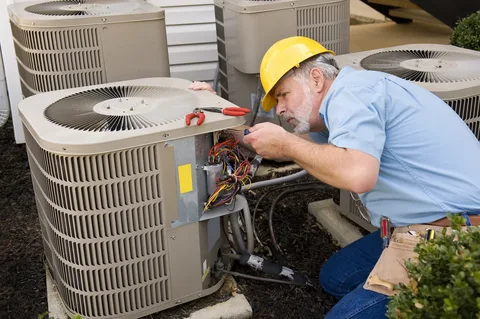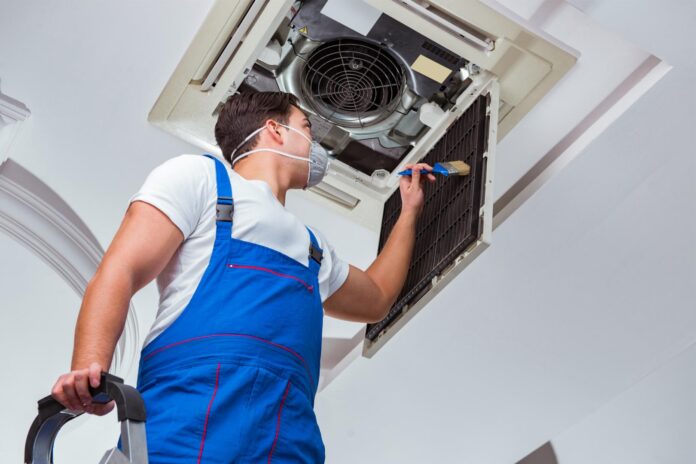As the weather gets colder and energy costs increase, homeowners are looking for ways to reduce their heating and cooling bills. One of the best investments a homeowner can make is in a heat recovery ventilator (HRV). An HRV helps to reduce energy costs by recovering the heat from stale air and transferring it to the fresh incoming air, thus reducing the need for artificial heating and cooling. In this blog post, we’ll discuss the importance of hiring a professional to install a HRV in your home and the potential cost savings and other benefits it can provide.
An Energy Recovery Ventilator Can Help Improve Your Indoor Air Quality
Indoor air pollution is a growing health concern and a significant cause of illness in the developed and developing world. A Recovery Ventilator (HRV) is a device that effectively reduces indoor air pollution and improves indoor air quality. An HRV is designed to circulate air throughout your home while also extracting stale, dirty air and pollutants. The incoming fresh air is filtered, cooled, or heated as needed and mixed with recycled stale air to provide optimal indoor air quality.
An HRV helps reduce the amount of airborne contaminants in your home, such as pollen, dust, pet dander, mold spores, smoke particles, and volatile organic compounds (VOCs). The system also helps to reduce the presence of dangerous carbon monoxide from gas-powered appliances. Additionally, an HRV can help minimize the effects of humidity by controlling the air’s moisture. Controlling the humidity can help prevent mold and mildew growth, which can cause respiratory problems and trigger allergies.
Overall, an energy recovery ventilator can improve indoor air quality, reduce allergens and irritants, decrease noise pollution, and reduce energy costs. That makes it an ideal choice for homeowners looking to improve their home’s indoor air quality.
An HRV Can Help Reduce Your Energy Costs.
Heat-recovery ventilators (HRV) are becoming increasingly popular to reduce home energy costs. Using an HRV, homeowners can save money on their heating and cooling bills by recovering the heat that would otherwise be lost through natural ventilation.
Heat Recovery, Ventilators work by taking in outside air and transferring the heat from it to the incoming fresh air. It means you can maintain a comfortable temperature within your home without spending as much energy. Not only does this result in lower energy bills, but it also helps to reduce your environmental footprint.
As well as reducing your energy bills, an HRV can also help reduce condensation in your home. It is because it reduces the amount of moisture in the air and makes sure it is evenly distributed throughout your home.
Overall, an HRV is a great investment for any homeowner looking to reduce their energy costs. It can help improve your home’s indoor air quality, reduce noise pollution, and ensure that your heating and cooling bills stay low.
An HRV Can Help Improve Your Respiratory Health.
One of the major benefits of hiring a (HRV) is the positive impact it can have on your respiratory health. An HRV continuously circulates fresh, filtered air throughout your home, removing pollutants, allergens, and other particles. It can help reduce the risk of respiratory illnesses such as asthma, allergies, and even bronchitis. Additionally, an HRV can help reduce the amount of moisture in the air, reducing the presence of mold, mildew, and bacteria. These factors can all contribute to improved respiratory health and comfort.
Providing clean air and balanced temperatures throughout your home, an HRV will create a more comfortable living environment. It can be beneficial for those suffering from chronic respiratory conditions. The clean air and stable temperature will also promote better sleep, allowing you to wake up refreshed and alert.
In short, a heat-recovery ventilator is an excellent investment for anyone who wants to improve their respiratory health. Not only can it provide cleaner air to breathe, but it can also help reduce humidity and create a more comfortable living environment. An HRV’s ability to maintain balanced temperatures makes it ideal for homes in hot or cold climates. You won’t need to constantly adjust the thermostat or worry about large energy bills since an HRV requires minimal energy usage. Using an HRV can also help reduce dust accumulation around your home, making it easier to keep tidy without worrying about dust build-up or breathing problems due to dust mites or pollen.
Installing an HRV is relatively straightforward; however, if you’re unsure how to do so properly, it’s best to contact professionals who are experienced in this field and know exactly what they’re doing. Professional installation ensures that everything is done correctly, making sure that your HRV runs at optimal efficiency while also reducing energy costs in the long run.
 An HRV Can Help Reduce Noise Pollution In Your Home
An HRV Can Help Reduce Noise Pollution In Your Home
Noise pollution can be a major issue for homeowners, especially if you live in a noisy area. A heat-recovery ventilator (HRV) is an effective way to reduce the amount of noise coming into your home. An HRV works by using a fan to draw fresh air from outside and exchange it with stale indoor air. This process reduces the noise that enters your home, as the fan operates at a low speed and is well-insulated. Additionally, an HRV reduces sound within the home by reducing drafts and helping regulate indoor temperature. With an HRV, you can enjoy peace and quiet in your home, without having to worry about outside noise. An HRV also provides improved ventilation in your home, which can help reduce the risk of mold or mildew growth. In addition, humidity levels will remain balanced since both warm and cool air are drawn from outside sources. The constant exchange of air prevents the buildup of dust particles and other allergens. It also ensures healthy levels of oxygen are maintained throughout your living space, making it easier to breathe clean, fresh air all day long.
Benefits Of Heat Recovery Ventilation System
Heat recovery ventilation system (HRV) is a great way to improve the air quality in your home while also helping to reduce energy costs. By installing an HRV, you can take advantage of the benefits of a well-ventilated indoor environment and improve the overall comfort of your home.
An HRV system works by transferring heat from one side of the unit to the other, which helps it maintain a steady temperature throughout your home. This transfer of heat also helps to reduce moisture levels and prevent the build-up of allergens and pollutants. In addition, an HRV system can help to improve your respiratory health by providing an optimal amount of fresh air without the need for open windows or fans.
In addition to improved air quality, HRVs also have the added benefit of helping to reduce energy costs. Because they reduce the need for additional heating or cooling, you can save money on energy bills. Furthermore, an HRV will also reduce noise pollution in your home, providing a quieter and more peaceful living environment.
Overall, an HRV is an excellent choice if you’re looking for a way to improve your indoor air quality and reduce energy costs. With a properly installed system, you’ll be able to enjoy the many benefits of a well-ventilated home while also reaping the rewards of reduced energy bills and improved respiratory health.
Conclusion
An HRV is an important addition to any home. It can help reduce energy costs, improve air quality, and reduce noise pollution. With its numerous benefits, it’s no wonder why so many homeowners are investing in HRVs for their homes. If you’re looking to increase the comfort of your home while also improving its energy efficiency, an HRV could be the perfect solution. Investing in one today could save you money and energy in the long run.
Related Websites
Articles on Blogshunt
Articles on Blogseu
Articles on Blogspeoples
Articles on Thebigblogtheory
Articles on Allcityforums


